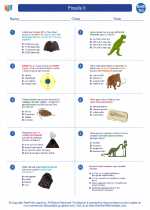Fossils II -> bones
Bones
Bones are the rigid organs that make up the skeleton of vertebrates. They provide structure, protect organs, anchor muscles, and store calcium. The study of bones is essential in understanding human anatomy and the skeletal system.
Structure of Bones
Bones are made up of two types of tissue: compact bone and spongy bone. Compact bone is the dense outer layer that gives bones their strength, while spongy bone is found at the ends and inside the bone and is lighter and less dense. Bones also contain bone marrow, which is responsible for producing blood cells.
Types of Bones
There are five main types of bones in the human body: long, short, flat, irregular, and sesamoid. Long bones, such as the femur and humerus, are longer than they are wide and are crucial for movement. Short bones, like those in the wrist and ankle, provide support and stability. Flat bones, such as the skull and ribs, protect internal organs. Irregular bones, like the vertebrae, have complex shapes and provide various functions. Sesamoid bones, such as the patella, are embedded within tendons and assist in joint movement.
Bone Functions
Bones serve several important functions in the body, including:
- Support: Bones provide a framework for the body and support muscles and organs.
- Protection: Bones protect vital organs such as the brain, heart, and lungs.
- Movement: Bones, along with muscles and joints, allow for movement and locomotion.
- Mineral Storage: Bones store minerals, particularly calcium and phosphorus, which are essential for various bodily functions.
- Blood Cell Formation: Bone marrow is the site of blood cell production, including red blood cells, white blood cells, and platelets.
Study Guide
To study bones effectively, consider the following tips:
- Learn the names and locations of major bones in the human body, such as the skull, vertebrae, ribs, pelvis, and long bones of the extremities.
- Understand the functions of bones and how they support and protect the body.
- Explore the structure of bones, including the composition of compact and spongy bone, as well as the role of bone marrow.
- Examine the different types of bones and their specific roles in the body.
- Utilize diagrams and models to visually understand the skeletal system and bone anatomy.



